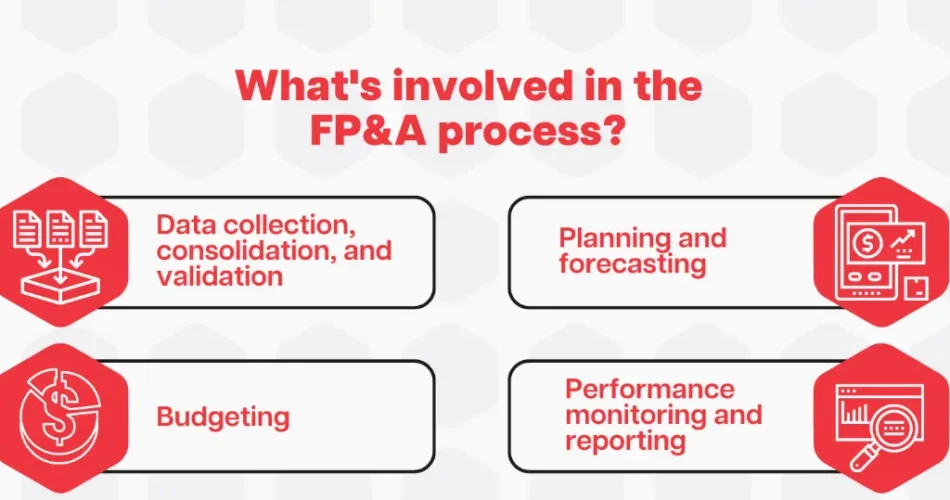In today’s competitive business environment, companies must make data-driven decisions to ensure profitability and sustainable growth. Financial planning & analysis software plays a crucial role in helping businesses manage budgets, forecast revenue, and analyze financial performance efficiently.
With so many software options available, finding the right one can be overwhelming. This guide will explore the best financial planning & analysis software in 2025, including their features, benefits, and pricing, so you can choose the right tool for your business.
Contents
What is Financial Planning & Analysis Software?

Financial Planning & Analysis (FP&A) software helps businesses with budgeting, forecasting, reporting, and financial data analysis. It enables finance teams to make strategic decisions by providing real-time insights, automating reports, and tracking key financial metrics.
Key Functions of FP&A Software:
✔ Budgeting & Forecasting: Helps businesses plan for the future based on data-driven insights.
✔ Financial Reporting: Generates automated financial reports and dashboards.
✔ Scenario Analysis: Allows businesses to evaluate different financial scenarios before making decisions.
✔ Data Integration: Connects with accounting, ERP, and other financial tools.
✔ Expense & Revenue Tracking: Monitors financial health in real-time.
Why Businesses Need Financial Planning & Analysis Software
Businesses, from startups to large enterprises, need FP&A software for several reasons:
1. Improved Decision-Making
With real-time data insights, businesses can make strategic financial decisions that boost profitability.
2. Increased Efficiency
Automating financial planning reduces manual work and minimizes human errors.
3. Better Budgeting and Forecasting
Accurate financial projections help businesses prepare for uncertainties.
4. Enhanced Collaboration
Teams can work together seamlessly with cloud-based financial planning tools.
5. Regulatory Compliance
Helps businesses meet compliance requirements and generate audit-ready reports.
Top 10 Financial Planning & Analysis Software in 2025
Here are the best financial planning & analysis software solutions for businesses in 2025, along with their features, benefits, and pricing.
1. Workday Adaptive Planning
Best for: Enterprises & Mid-Sized Businesses
Features:
✔ Advanced budgeting & forecasting tools
✔ AI-powered financial modeling
✔ Real-time collaboration & dashboards
✔ Integration with ERP and accounting systems
Pros:
✅ Scalable for growing businesses
✅ AI-driven insights for smarter planning
✅ User-friendly interface
Cons:
❌ High pricing for small businesses
❌ Requires training for complex features
Pricing: Contact Workday for pricing details
2. Oracle NetSuite Planning & Budgeting
Best for: Large Enterprises
Features:
✔ Cloud-based financial planning
✔ Predictive analytics & scenario planning
✔ Automated data consolidation
Pros:
✅ Powerful financial analysis tools
✅ Strong integration with NetSuite ERP
✅ Secure cloud-based solution
Cons:
❌ Expensive for small businesses
❌ Learning curve for beginners
Pricing: Starts at $499/month
3. Anaplan
Best for: Large Corporations
Features:
✔ Enterprise-wide financial planning
✔ AI-powered predictive analytics
✔ Cloud-based collaborative planning
Pros:
✅ Excellent for complex financial planning
✅ Strong collaboration tools
✅ Real-time forecasting
Cons:
❌ High cost
❌ Requires IT support for setup
Pricing: Custom pricing based on business needs
4. Planful (formerly Host Analytics)
Best for: Mid-Sized Businesses
Features:
✔ Financial reporting & budgeting
✔ Automated workflows
✔ Scenario modeling
Pros:
✅ Affordable compared to enterprise solutions
✅ Strong reporting tools
✅ Easy to implement
Cons:
❌ Limited customization
❌ Basic AI features
Pricing: Starts at $600/month
5. Vena Solutions
Best for: Small to Mid-Sized Businesses
Features:
✔ Excel-based interface
✔ Custom financial models
✔ AI-powered analytics
Pros:
✅ Easy to use for Excel users
✅ Great for budgeting & forecasting
✅ Affordable for SMBs
Cons:
❌ Limited automation features
❌ Can be slow with large data sets
Pricing: Custom pricing based on user needs
6. Cube Software
Best for: Startups & SMBs
Features:
✔ Budgeting & forecasting tools
✔ Pre-built financial templates
✔ Integration with QuickBooks & Xero
Pros:
✅ Simple interface
✅ Great for small businesses
✅ Cost-effective
Cons:
❌ Limited features for large enterprises
❌ Less AI-driven insights
Pricing: Starts at $125/month
7. Centage Planning Maestro
Best for: Small Businesses
Features:
✔ Automated financial forecasting
✔ Customizable dashboards
✔ Integrated financial statements
Pros:
✅ Affordable for small businesses
✅ Easy to use
✅ Strong forecasting tools
Cons:
❌ Limited scalability
❌ Fewer advanced features
Pricing: Starts at $249/month
8. Jedox
Best for: Enterprises & Large Businesses
Features:
✔ AI-powered financial planning
✔ Advanced predictive analytics
✔ Cloud-based & on-premise options
Pros:
✅ AI-driven forecasting
✅ Strong customization options
✅ Enterprise-grade security
Cons:
❌ Expensive
❌ Requires expert training
Pricing: Custom pricing available
9. Prophix
Best for: Mid-Sized to Large Enterprises
Features:
✔ Data-driven financial modeling
✔ AI-based anomaly detection
✔ Workflow automation
Pros:
✅ Highly customizable
✅ Strong data visualization tools
✅ Secure cloud storage
Cons:
❌ Costly for small businesses
❌ Complex setup process
Pricing: Contact Prophix for details
10. Float
Best for: Small Businesses & Startups
Features:
✔ Real-time cash flow forecasting
✔ Integrates with QuickBooks, Xero & FreeAgent
✔ Simple financial planning dashboard
Pros:
✅ Best for startups & small businesses
✅ Affordable pricing
✅ Easy to set up
Cons:
❌ Lacks advanced financial modeling
❌ Basic reporting features
Pricing: Starts at $99/month
How to Choose the Best Financial Planning & Analysis Software
When selecting financial planning & analysis software, consider the following factors:
1. Business Size & Needs
Choose software that fits your company’s size and complexity.
2. Ease of Use
Ensure the software is user-friendly and easy to integrate with existing tools.
3. Features & Customization
Look for essential features such as budgeting, forecasting, and scenario analysis.
4. Pricing & Scalability
Select software that fits your budget and can scale as your business grows.
5. Customer Support
Reliable support is crucial for smooth implementation and ongoing use.
Conclusion
Choosing the right financial planning & analysis software can transform your business by improving financial accuracy, efficiency, and decision-making. Whether you’re a small business owner, a startup, or a large enterprise, there’s a solution that fits your needs and budget.
